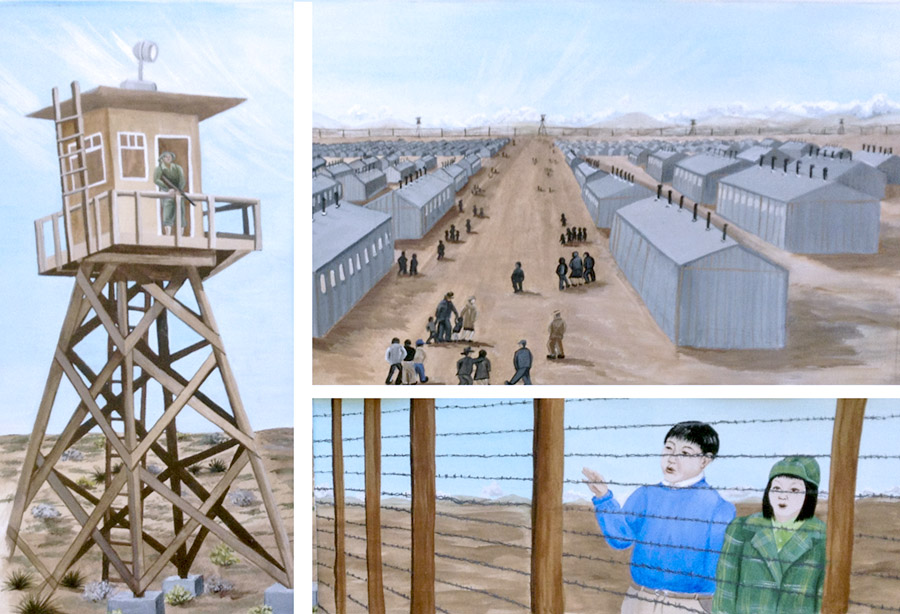
Various prints telling the story of “Yuki and Taro” that are available as part of the teaching unit. (Photos: Courtesy of Becky Brendlin Sugiyama)
The teaching unit, created by three former teachers from the Sonoma County JACL, is available to educate others on the incarceration experience.
Three women from the JACL’s Sonoma County Chapter received a National JACL Legacy Grant to implement a teaching unit about the Japanese American incarceration experience during World War II. Storywriters Sachiko Knappman, Cynthia Kishi and artist Becky Brendlin Sugiyama came up with the idea for their project in January 2017 and received the support of their JACL chapter to develop this teaching unit.
Their idea was to create an engaging means of educating students about the history of the injustice served to people of Japanese ancestry. The project taps into young children’s sense of compassion and through conversation, brings out concepts of civil rights and social justice. Its original intent was to be used primarily in elementary school, but it has been adapted to other grades and even service groups as well.
Keeping in mind that a story about children would be relatable for younger children, the main characters are siblings Yuki and Taro, who are 8 and 12, respectively. Their family is forced to leave their farm in Northern California after Japanese planes bomb Pearl Harbor in 1941.
The story takes participants through the family’s experience, from packing only what they could carry to leaving treasured animals and possessions behind, as they travel by train to an assembly center and then on another train to an unknown destination.
The family ends up incarcerated in a “camp,” and the children are shocked to discover that they are prisoners behind barbed-wire fences. Life for the family has been forever changed, and they must now learn how to endure and make the best out of a situation that has been forced upon them. When the family finally returns home four years later, they find that some things are the same, but many things are also very different.
Knappman, Kishi and Sugiyama, all former teachers, have taken their project into classrooms to perform their story using Kamishibai or “paper theater.” There are 20 colorful prints of paintings that were created especially for the story. Through the use of Kamishibai, the story comes alive from behind the doors of a wooden briefcase that opens to create a butai or “stage” that frames the prints. Participants gather in front of it and listen as the story unfolds.
In addition, follow-up questions and activities are included with the teaching unit. Suggestions include role-playing, hands-on cultural activities and a book and movie list for different grade levels.
The entire project is available free of charge and includes scans of the paintings, the story, educational documents and supplements and PowerPoint presentations — all available on the Internet through the Sonoma County chapter’s website.
In May, Knappman and Sugiyama appeared on an episode of the Bay Area’s “Asian Pacific America With Robert Handa” to discuss their storytelling project.
“Our show, ‘Asian Pacific America,’ has addressed the Japanese American internment ordeal in many ways, and the ‘Yuki and Taro’ Kamishibai project was one of the most effective,” said the show’s host, Robert Handa. “[It] is one of the most interesting and important efforts launched with the noble mission to enlighten elementary grade youth to an important part of history. The traditional method of storytelling keeps the educational process visually interesting, compelling and authentic for youth.”
And the women have also received much positive praise and feedback from teachers and students who have participated in the teaching unit.
“Thank you so much for speaking to our class,” one teacher commented. “Your message was so powerful and has sparked very meaningful class discussions. We really loved hearing your story, witnessing your illustrations and learning about origami. Thank you again for your engaging and meaningful presentation.”
Added several students, “Thank you for showing us no matter what, don’t give up,” “I learned not to judge people by how they look,” “It taught me to be nice to everyone and treat everyone like I want to be treated” and “Thank you for teaching us that we can make a difference!”
For more information on how to bring this project into your local JACL chapter, visit www.sonomacojacl.org and click on “Speakers Bureau and Kamishibai Project.”



